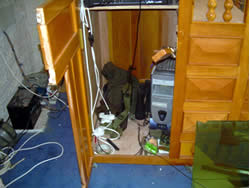
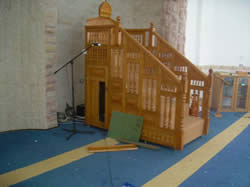
| THINK-ISRAEL |
| HOME | March-April 2009 Featured Stories | Background Information | News On The Web |
The use of mosques for military and political purposes by Hamas
and other terrorist organizations and Islamic groups: according to
international laws governing of armed conflict, mosques used for
military purposes lose the special protection afforded houses of
worship and may become legitimate targets for attack.


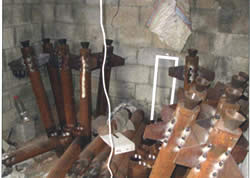
1. Operation Cast Lead illustrated the varied military uses made by Hamas of the mosques under its control in the Gaza Strip. During the operation evidence (which was extensively documented by the Intelligence and Terrorism Information Center) was found about the storage of weapons in mosques (rockets, IEDs, light arms and even an anti-aircraft gun), and about using the mosques for military training and as bases from which to launch rockets into Israel and mortar shells at IDF forces nearby.
2. The extensive use made of mosques by terrorist organizations and radical Islamic groups for military, terrorist and political purposes is not limited to the Gaza Strip . This study also examines similar uses made by Hamas in Judea and Samaria, Hezbollah in south Lebanon, and global jihad and other radical Islamic groups in various countries around the Arab-Muslim world (in conflict focal points such as Iraq and Pakistan) and even in the Muslim communities in Europe. In many locations both in the Middle East and beyond, radical Islamic terrorist organizations exploit the mosques to hide weapons, organize in preparation for attacks, enlist supporters and terrorist operatives, preach terrorism and indoctrinate Muslims who come to worship with hatred for Israel, the Jewish people, the West in general and the United States in particular, as well as for pro-Western Arab and Islamic regimes.
3. The study also examines the religious and social roots of the use of mosques for military and political purposes. Senior Islamic clerics, both Sunni and Shi'ite (particularly the Sunni sheikh Yussuf Qardawi and the Shi'ite Ayatollah Khamenei), repeatedly claim that making such use of the mosques for jihad objectives is legitimate according to Islamic point of view. They also encourage their use for spreading jihad ideology and terrorism (muqawamah , i.e., "resistance") against the enemies of Islam . Their religious views are based on the Islamic oral traditions (hadiths) which say that the prophet Muhammad himself used a mosque for military and political purposes, beyond the classic use of the mosque as house of worship.
4. The use made by terrorist organizations of mosques for military purposes and as launching pads for terrorist attacks is liable to endanger innocent civilians who have no link to the organizations. It harms the status and special protection afforded houses of worship by international laws of armed combat, as well as the protection afforded civilian structures and the civilian population in general. The laws of armed conflict unequivocally state that houses of worship used for military purposes lose their right to protection and thus expose themselves to attack . Hamas and Islamic terrorist groups claim that attacking mosques (even though they were put to military-terrorist purposes) is illegal and is an infringement of the freedom of worship. Those claims, aimed primarily at Western ears where public opinion regards the mosques as places used exclusively for religious purposes, are worthless. The measures taken by the IDF in the Gaza Strip against mosques used for military purposes, as well as those taken by other countries, including, for example, the United States in Iraq, were in accordance with international law and arose from the natural commitment of any state to defend its citizens .
5. The legitimate battle against the military and political use made of mosques by terrorist organizations and radical Islamic elements has been waged in various ways: during Operation Cast Lead in the Gaza Strip , the IDF attacked mosques used for such purposes by Hamas; in Iraq , the United States attacked mosques in Fallujah and other cities because they were being used as military bases by insurgents and other terrorist elements; in Judea and Samaria the Palestinian Authority invaded mosques controlled by Hamas and confiscated weapons and propaganda materials, and detained clerics; in Pakistan the regime was forced to take over the entire Red Mosque precinct in Islamabad, where radical Islamic activities were being held and from which terrorist groups affiliated with the global jihad launched their attacks.
6. Arab countries such as Saudi Arabia have been forced to impose close security supervision on the mosques which are home to global jihad groups whose activities are also directed against the host countries (the sheikh of Al-Azhar mosque, Muhammad Al-Tantawi, who is a senior religious authority in the Sunni Muslim world, determined that a country has the full right to attack a mosque to preserve its security interests ). In addition, European countries (especially Britain ) and the United States were also forced to impose close security supervision on mosques which had become focal points for global jihad incitement and terrorist activities, especially after September 11, 2001 .
7. The radical Islamist terrorist exploitation of mosques for military and political purposes can be expected to continue. The struggle against such exploitation has met several serious difficulties, especially since in many places Islamic terrorist organizations enjoy great popularity with those who come to the mosques (popularity which is sometimes greater than that of the countries and regimes fighting terrorism, each in its own way). Nevertheless, the struggle must be continued in a variety of ways as an integral part of the global war against terrorism and its various manifestations.
Contents
I: The use made by Hamas of mosques in the Gaza Strip for military and political purposes
II: The use made by Hamas of mosques in Judea and Samaria for military and political purposes
III: The use made by Hezbollah of mosques in south Lebanon for military purposes
IV: The use made of mosques in the Arab and Muslim world for military and political purposes
V: Religious and social roots of the use of mosques for political purposes
8. The extensive network of mosques in the Gaza Strip, which has become significantly larger during the past 30 years, is for the most part controlled by the Hamas movement. The main reasons for its control, are the popularity of Hamas's radical Islamic ideology, its extensive social welfare activities, the difficulties experienced by Fatah (whose orientation is secular and national) in gaining a foothold in the mosques, the lack of a strong central government with the ability to control the mosques as is usually done in Arab countries, and Hamas's political domination of the Gaza Strip since June 2007. The Hamas takeover of the Gaza Strip made it possible for the movement to strengthen its control of the mosques and to remove clerics belonging to the rival camp. Hamas and the other terrorist organizations use the mosques to recruit operatives for terrorist attacks, store weapons, hold terrorist operative meetings, and as bases for terrorist attacks, training sites and rocket and mortar shell launching sites.
9. The large number of mosques spread throughout the Gaza Strip, the relative security Hamas operatives feel within them and the religious roots for using them for military purposes (See below) encourage Hamas to exploit them for military purposes and make them a central component in fighting the IDF forces in built-up areas. Hamas assumed, at least until Operation Cast Lead, that the IDF would refrain from attacking mosques, regardless of the military activity taking place in them, because they were religious institutions and attacking them would cause a negative reaction in the Arab countries and even the West, where there is a long-standing tradition of the sanctity of places of worship.
10. The use of a mosque for military purposes was revealed during counterterrorist Operation Hot Winter (March 2008) in the northern Gaza Strip. During the operation an IDF force found a cache of weapons hidden in a mosque in the Jabaliya refugee camp. There were telephone-detonated IEDs, coils of cable for activating bombs, mortar shells, hand grenades and ammunition clips. Cables for activating charges inside the mosque were found, as were parts of ammunition clips, showing that terrorist operatives had fired from within the mosque. Left: IDF forces searching a mosque in the Jabaliya refugee camp in the northern Gaza Strip during Operation Hot Winter. Right: Weapons found in the mosque, among them mortar shell and grenades (IDF Spokesman, March 2, 2008).
11. On April 16, 2008, an IDF force operating in the northern Gaza Strip attacked ten armed terrorists. During the exchange of fire the terrorists launched mortar shells and anti-tank missiles from within a mosque on the outskirts of Saja'iya, in which they had hidden large quantities of IEDs and other weapons. (IDF Spokesman, April 16, 2008).
12. During Operation Cast Lead (December 2008-January 2009) Hamas and the other terrorist organizations extensively used mosques for military-terrorist purposes. Israel, on the other hand, rose to the challenge and attacked mosques in which or from which military actions were taken. During the operation evidence was found for a variety of uses to which the mosques were put:
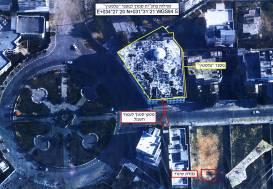
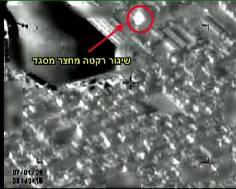
13. Dr. Taleb Abu Shaar, endowments minister in Hamas's de facto administration, protested the IDF attacks on the mosques during Operation Cast Lead. He said that Israel's claims that the mosques served as weapons storehouses were not proved and that the Palestinian people had the right to full "freedom of worship." He said that Israel had acted contrary to international law, human morality and religious principles. He added that it was a manifestation of the "religious war Israel is waging against Islam" (Hamas's Palestine-info website, February 1, 2009).
|
14. Representing the attacks on mosques used as military bases as an attack on "freedom of worship" is a lie whose objective is to score points for Hamas in its propaganda war against Israel. In fact, the mosques which Israel attacked were clearly used for military purposes in grave breach of the laws of armed conflict, and an exploitation of the special protection afforded religious institutions. The cynical and deliberate use of religious institutions for military purposes is a violation of the laws of armed conflict and may turn them into legitimate targets for military attack. In certain instances putting the mosques to such use is considered the war crime of using civilians as human shields. Thus it is not a question of Israel's waging a "religious war" or attacking Palestinian civilians, as Hamas propaganda claims, but of legitimate attacks on military-terrorist targets, which were in compliance with international legal rules and with the State of Israel's commitment to defend its citizens. |
15. The mosques in the Gaza Strip are used as forums for political incitement and hatred for the State of Israel, the Jewish people, the United States and even the Palestinian Authority and various Arab regimes. The themes of hatred appear in the Friday sermons, which also include political discussions of current events.
16. Conspicuously anti-Semitic sermons were given at the end of the Arafat era by Sheikh Ibrahim Mudeiras, a Hamas-affiliated cleric. They were delivered on Fridays at the Zaid Bin Sultan Aal Nahyan mosque in Gaza City and broadcast live via Palestinian TV, which was under the supervision of the Palestinian Authority[3] (the broadcasts on Palestinian TV ended during the Mahmoud Abbas era). Currently the most conspicuous inflammatory preacher is Sheikh Yunes al-Astal, a Hamas representative in the Palestinian Legislative Council. For example, in a Friday sermon broadcast by Hamas Al-Aqsa TV he announced that Islam would soon conquer Rome, "the Catholic or Crusader capital," as in the past Islam conquered Constantinople, and from there it would continue and conquer both Americas and even Eastern Europe (Al-Aqsa TV, April 11, 2008).
17. During the violent campaign waged by the terrorist organizations against Israel many mosques in the Palestinian Authority-administered territories, some of them as a result of Hamas influence, served as centers for incitement to terrorism and hatred. Sometimes they also served as launching pads for terrorist attacks against Israel. In the Gaza Strip, which is under Hamas domination, incitement and military activity have taken place in the mosques without interference, but in Judea and Samaria, at least theoretically, the activities of Hamas and the other terrorist organizations in the mosques are expected to be controlled by the Palestinian Authority.
18. The mosques in Judea and Samaria are subject to inspection by the Palestinian Authority's security services and by its endowments and religious affairs ministry. Moreover, some of the more extremist preachers, including those affiliated with Hamas, are paid by the ministry and are in fact PA employees. In reality, however, the PA finds it difficult to maintain effective continuous supervision of the mosques, which over the years have become sites of Hamas influence where anti-Israel and anti-PA propaganda is preached and where terrorism is indoctrinated.
19. During the terrorist campaign (the second intifada) the mosques in Judea and Samaria have been used for the following purposes:
It noted that "all mosques in Al-Bireh serve as sorts of offices for the Hamas movement," and suggested that the Palestinian Authority security services appoint reliable individuals to be responsible for each mosque "for the sake of order and control."[4]4 Only during the past year did the Palestinian Authority take more decisive steps to counter Hamas's control of the mosques (see below).
20. The Al-Ayn mosque in Al-Bireh, where Hamas is particularly vigorous in disseminating propaganda and which has been exploited as a meeting place for Hamas terrorist operatives, is a good test case. On October 1, 2003 the IDF conducted a search of the mosque and found many posters and flyers with anti-Israeli, anti-Semitic and anti-Western themes. They were hung on the front door of the mosque and on its bulletin boards, and flyers were also handed out to people who came to the mosque to pray. The most prominent preacher at the Al-Ayn mosque was Bassam Nihad Ibrahim Jarrar, and the imam was sheikh Feisal Muhammad Salah Hamdan, a senior Hamas activist and Muslim Brotherhood leader in the PA-administered territories. For that both were detained a number of times by the Israeli security forces.[5]
21. Hamas activist Bassam Nihad Ibrahim Jarrar, after his release from an Israeli jail, became director of the Nun Center for Qur'an studies. He also continued his propaganda activity in mosques. A video posted on YouTube on January 1, 2009, shows an old sermon he gave at the Al-Umari mosque in Ramallah. In it, he referred to the Jordanian and Egyptian leaders, including King Hussein, the late Anwar Sadat and President Mubarak, as "spies" accused their regimes of "spying" for the CIA and not serving Arab and Islamic interests. He also noted that it would be the fate of the State of Israel to disappear.[6]
22. At various times during the Arafat and Mahmoud Abbas eras, the Palestinian Authority made attempts to supervise the mosque preachers and their sermons, knowing full well that the sermons were also directed against it. Political sermons were forbidden, the preachers had to send copies of their sermons to the PA for approval and sometimes preachers affiliated with Hamas were fired or even detained. The PA's attempts have continued to this day, but their success is still uncertain and greatly dependent on develops in the internal Palestinian arena.
23. Since the end of 2007 the PA has taken more intensive measures against Hamas's civilian infrastructure (the da'wah) in Judea and Samaria. Salam Fayyad's government and the Palestinian security services have acted against the mosques, many of which have traditionally been under Hamas control. The PA has focused its actions in the Nablus and Hebron districts, where Hamas enjoys great influence within the local population. The PA security forces had raided the mosques dozens of times, confiscated propaganda material, detained preachers and in some cases replaced them.
24. At the end of 2007 the PA's security services took action against Hamas-affiliated mosques in the Nablus district. They uncovered weapons stores, military uniforms and Hamas flyers in the basement of the Musab Abu Amir mosque in the Askar area of Nablus. Akram al-Rajoub, head of preventive security for Nablus, reported that the operation was "part of the PA's efforts to prevent the politicization of the mosques and sites of worship...because Hamas uses [them to promote] its own narrow objectives and military interests" (Ma'an News Agency, November 19, 2007). Ahmed al-Sharqawi, Nablus police chief, said that his men respected the mosques but had detained Hamas activists who had stored weapons and ammunition in them and loaded mosque computers with propaganda material (Radio Voice of Palestine, September 29, 2007). Hamas accused the Palestinian Authority and Fatah of threatening to replace the imams and preachers in the mosques with their own men on the grounds that the security services forbade politics being discussed in the mosques, and forced the preachers to keep to themes acceptable to the ministry of endowments, and that they had threatened to detain anyone who did otherwise (Hamas's Radio Al-Aqsa, October 7, 2007).
25. To enforce its authority in the Hebron district, the Palestinian Authority undertook activities to prevent incitement in the mosques. For example, according to an announcement issued by Palestinian military intelligence on September 9, 2008, propaganda materials were confiscated in six mosques in Hebron, including incitement against the PA itself (Ma'an News Agency, February 9, 2008). On August 30, 2008, PA security services raided mosques in the town of Sureif in the Hebron district. A surfer on Hamas's PALDF forum (August 30) uploaded photographs from a mosque raided by the PA security services, as well as a Hamas flyer warning the PA not to defile the sanctity of the mosque.
26. The Palestinian Authority's activities to enforce its effective control over Hamas- dominated mosques are still far from completion. Sheikh Jamal Muhammad Ahmed Bawatna, minister for endowments and religious affairs in the Salam Fayyad government, recently warned that changes could be expected in the ministry, hinting that preachers "who do not adhere to the message of the mosques and of the ministry [of endowments]" would be dismissed. He added that "in the last few days a number of preachers and guides in the mosques have exploited the freedom given them...Anyone who wants to expound election propaganda should go to the radio and television stations..." (from an interview with the German News Agency on the Qudsnet website, February 15, 2009).
27. A Ynet posting by Ali Waked on February 24, 2009 described the struggle waged by the Palestinian Authority against Hamas activists in the mosques. It includes "reeducating" the preachers and the dismissal of dozens (there are those who claim hundreds) of Judea and Samaria imams affiliated with Hamas, especially in the more important mosques. The sermons are given only by moderate imams affiliated with the PA, who in ordinary times are allowed to speak only about religion and are forbidden to avoid inciting those who come to pray (Note: During Operation Cast Lead they were permitted to let off steam and speak against the fighting).
28. A preacher in one of the mosques in the Ramallah district told Ali Waked that "every so often we get a circular from the ministry of religious affairs which tells us what the topic of the weekly sermon is supposed to be, and we aren't allowed to talk about anything else...We haven't talked about politics for a long time." In Ramallah people say that the Palestinian Authority's security services oversee the mosques' activities, and renegade imams are detained and replaced.[7] Hamas recently claimed that 50 imams were dismissed because of their affiliation with the movement. A Fatah member told Ali Waked that it was clear to the PA that taking over the mosques was a blow to Hamas: "[Taking] control of the mosques is like the struggle against the charitable societies or Hamas's armed networks."
29. The second Lebanon war revealed the vast military infrastructure constructed by Hezbollah in the populated areas of south Lebanon and the exploitation of Lebanese civilians as human shields. Situating its offensive and defensive military networks in densely populated areas was intended to reduce potential damage to the organization and to give it a kind of immunity from IDF attacks (knowing that the IDF is committed to refraining from harming the civilian population insofar as is possible).[8]
30. It was also proved that Hezbollah customarily situates its military installations around public institutions such as religious institutions, schools and hospitals to make it difficult or to prevent the IDF from attacking. Hezbollah also exploited it for propaganda against Israel as part of the battle for hearts and minds by represented Israel as attacking public institutions regarded as protected places by the Geneva Convention.
31. The following are examples of religious institutions used for military purposes during the second Lebanon war: [additional photos are in the original paper]
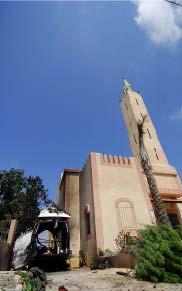
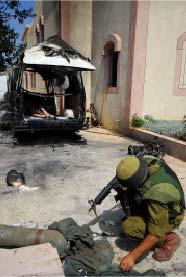
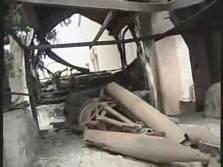
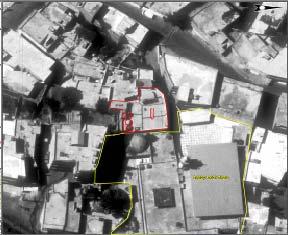
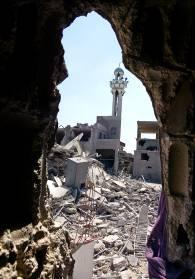
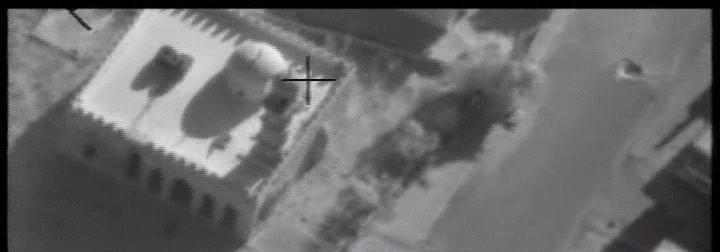
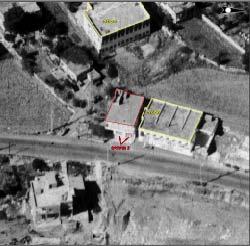
33. Following are examples of the use made of mosques for military and political purposes in Arab and Muslim countries and in Muslim communities in Europe and the United States.
34. The extensive military use made by terrorist elements of mosques was exposed by the large-scale offensive mounted by American and Iraqi forces in the cities of Fallujah (west of Baghdad) and Samara (north of Baghdad) in 2004 (particularly in October and November). In those cities, the American and Iraqi forces had to fight gunmen who took shelter in mosques and turned them into bases for military and terrorist activities. For example:
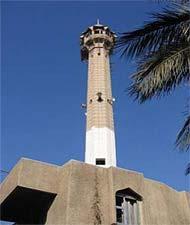
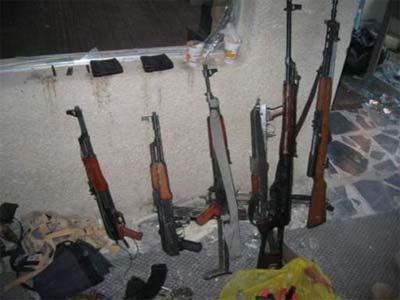
35. A prominent incident took place in Fallujah when US marines surrounded and assaulted the Hajj Mohsen Abd al-Aziz al-Qubeisi Mosque compound. It had been turned into a hiding place for insurgents, who fired RPG missiles, mortar shells and small arms (globalsecurity.org, April 7, 2004). General Mark Kimmitt, Deputy Director for Coalition Operations in Iraq, said that US forces dropped two 227kg bombs on the wall of a mosque in Fallujah where insurgents were hiding (Ynet, April 8, 2004).
36. The American attack on the Fallujah mosque and Mark Kimmitt's statement were met with mixed reactions by Arab web surfers. Some sided with the general, while others accused the Americans of attacking the Islamic religion. Other surfers said that mosques should not be used for military purposes. One, an Egyptian citizen, noted that mosques should not be used for war because the American "occupation forces" in Iraq had no respect for holy places. A surfer from Iraq wrote that the Americans should not be given any excuses to defile the mosques. Yet another surfer lashed out at Islamic terrorists for having perpetrated terrorist attacks in churches and synagogues worldwide, twisting true Islam and turning mosques into weapon storehouses.[12] Mark Kimmitt stated that "if mosques turn into military outposts, they are no longer places of worship but rather military targets, so they can be targeted by our forces" (BBC in Arabic, April 19, 2004). Aerial photograph of the Hajj Mohsen Abd al-Aziz al-Qubeisi Mosque compound in Fallujah. Armed insurgents fighting against coalition forces made use of the mosque for military purposes (globalsecurity.org, April 7, 2004).
37. More examples of using mosques in Iraq for anti-American and anti-Jewish incitement as well as for storing arms and ammunition:
38. Iraqi mosques also serve as the sites of violent confrontations between Sunnis and Shi'ites, which has in many cases led to attacks on mosques. For example, on August 27, 2007, a suicide bomber blew himself up in a Sunni mosque in Fallujah during the evening prayers. The explosion killed ten worshippers, including the imam of the mosque (boston.com, August 28).
39. Following the September 11, 2001, attacks, the Saudi government took action against mosques harboring operatives belonging to Al-Qaeda and other Islamist terrorist organizations. For example, in July 2003, the Saudi security forces exchanged fire with Islamic terrorist operatives who barricaded themselves in a mosque in the village of Suweir (northern Saudi Arabia). The terrorists refused to surrender and used explosive belts to blow themselves up inside the mosque.[16]
40. On July 8, 2004, the Saudi Islamic Affairs and Waqf (religious endowments) Minister Saleh Bin Abd al-Aziz Aal al-Sheikh warned that preachers in Saudi Arabian mosques were inciting the worshippers to wage jihad outside the borders of the country.[17]
41. Mosques in Saudi Arabia are also used to spread anti-Semitic incitement by influential, reputable clerics:[18]
42. A clear example of a mosque turned into a hotbed of terrorism and incitement against an Islamic regime is the Red Mosque, the central mosque of Islamabad, which was attacked after activities there could no longer be controlled. There were two madrasas (religious schools) on the mosque grounds, one for men and one for women. The attack on the mosque compound, where hundreds of gunmen had barricaded themselves, took place on July 10, 2007, and led to the deaths of about one hundred supporters of radical Islam in Pakistan, including their leader, Abd al-Aziz Ghazi, the mosque's deputy imam.
43. The attack was carried out in response to earlier mass-casualty terrorist attacks, some of them suicide bombings, carried out by Abd al-Aziz Ghazi's supporters. They were perpetrated after Ghazi's announced in April 2007 that Islamic religious law (shari'a) would be imposed in regions he controlled and that an Islamic court would be established, which would issue verdicts competing with state law. In addition, mosque administration sent students from the two schools to serve as morality police to impose Islamic religious law on all of Pakistan. On July 3, 2007, students attacked a police roadblock and nearby government offices and set cars on fire, killing 16 people.
44. After Abd al-Aziz Ghazi declared an Islamic revolution on July 7, 2007, the Pakistani army launched an offensive against the people barricaded in the Red Mosque, killing over a hundred of them, including Ghazi himself. In addition, various weapons and letters containing instructions from the Al-Qaeda leadership were found in the compound. Ghazi and his father, the mosque founder Maulana Abdullah (killed in 1998), had a direct connection with the Taliban and were Al-Qaeda supporters. The Red Mosque compound (Al-Rai al-Aam, July 9, 2007)
45. Mosques in Britain served as recruitment pools of local young Muslims of Pakistani descent for the Lashkar-e-Taiba terrorist organization (which cooperates with Al-Qaeda and is responsible for the Mumbai terrorist attacks on November 26-28, 2008). A Lashkar-e-Taiba operative of Pakistani descent named Shafik ur-Rehman served as the imam of Oldham's Ross Street Mosque, (greater Manchester) and was considered the representative of Markaz-ud-Dawa wal-Irshad (Lashkar-e-Taiba's mother organization) in Britain. Shafik ur- Rehman was accused by the British authorities of raising funds for Lashkar-e-Taiba in 1999- 2000 and of supporting the organization (which he admitted). Also, he allegedly sent young Muslims to training camps near Lahore, Pakistan (which he did not admit). The British authorities were going to deport him but did not, and he still resides in Oldham. According to an article published in the British newspaper The Sunday Times (May 2004), one of the Ross Street Mosque recruits was trained to hijack a Boeing 767 and was supposed to take part in the September 11 terrorist attacks in the US.
46. Some mosques in Britain spread anti-Western and anti-Jewish propaganda and incitement, which is fairly common in radical Islamic mosques. Details can be found in a report published by the British institute Policy Exchange in 2007. The report, which deals with incitement in British mosques in 2006-2007, is based on activities monitoring various mosques in Britain. The report indicates that the mosques are used for preaching terrorism, violence and rabid incitement against the West and the Jews, using sermons and book sales. A religious ruling (fatwa) was found in terrorist East London mosque according to which infidels must be beheaded. A Friday sermon in the North London Central Mosque, said that jihad was a duty of modern-day Muslims, and that their leaders should mobilize them with that goal in mind. One of the books found in the East London Tawhid Mosque says that obeying laws which contradicted Islam and preferring them to Islamic laws was apostasy.[20]
47. There have also been reports of global jihad operative activities taking place in British mosques. For example, according to police sources in Britain, concealed weapons found in a London mosque in 2003 were used by terrorists associated with the terrorist Abu Hamza al-Masri;[21] six people were arrested in London, Southwell, and Luton on April 24, 2007 who were involved in preaching worldwide terrorism in mosques and in fundraising for terrorist activities in mosques about two and a half years previously.[22]
48. On July 21, 2007, the Italian police confiscated a bomb and chemical substances in a mosque in central Italy. During the operation, the police arrested several operatives apparently associated with Al-Qaeda, all of Moroccan descent.[23]
49. On June 6, 2003, an anti-Western sermon was delivered in a mosque in Rome. The preacher, of Egyptian descent, said "Allah, bring victory to the holy warriors in Palestine, Chechnya, and everywhere else! Allah, destroy the homes of the enemies of Islam!"[24]
50. On September 11, 2002, the German police raided a mosque in Hamburg and arrested a radical Islamic operative who was allegedly planning a terrorist attack in Germany.[25]
51. On January 24, 2008, ten global jihad operatives were arrested in a mosque in Barcelona. They were allegedly planning a suicide bombing attack in that city.[26]
52. Law enforcement agencies seem have increased their security control over mosques in the United States following the September 11 terrorist attacks.[27] However, we do not have reliable information on the subject. In one incident, it was reported that an Al-Qaeda terrorist cell was operating in Al-Farouq Mosque, Brooklyn, New York. It had allegedly been raising funds for that organization for many years.[28] In another incident, it was reported that FBI forces raided a mosque in Pittsburgh, Pennsylvania to arrest a suspect.[29]
53. On May 8, 2008, the United States Senate Committee on Homeland Security and Governmental Affairs published a report entitled "Violent Islamist Extremism, the Internet and Home-Grown Terrorist Threat" which dealt with the extensive Internet activities of Al-Qaeda, global jihad elements, and groups associated with radical Islam.[30]
54. According to the report, radical Islam operatives are highly active on chat groups and forums, which have become a virtual substitute for convening in mosques and community centers, where they sometimes meet with opposition to their extremist messages. The web surfers are usually young, and there is a constant rise in the number of women participating in chats and forums. Chats allow the personal connections to be established between Islamic terrorist operatives, who can exchange e-mails and cell phone numbers and continue their relationship in the real world.
55. One of the most prominent and influential zcontemporary Muslim clerics to make extensive use of the Internet to distribute distinctly political radical religious rulings is Yussuf al- Qardawi:
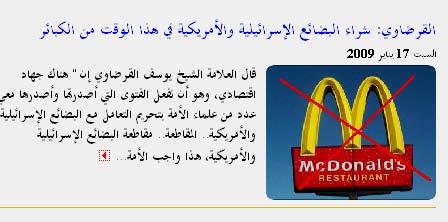
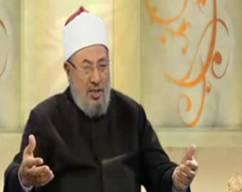
56. Sheikh Dr. Yussuf Mustafa al-Qardawi was born in Egypt in 1926. During his studies in Al-Azhar University he took an active role in the resistance against the British presence in Egypt, inspired by the radical Islamic ideology of Hassan al-Banna (founder of the Muslim Brotherhood). Because of his preaching against the British, and later against Nasser's government, al-Qardawi spent many years in prison. It is possible that his excessively provocative statements led to his dismissal from Al-Azhar University in 1961 and his appointment to director of the university's branch in Qatar. It was that move, however, which set him apart as an independent cleric who did not rely on the establishments of Arab countries. 57. In 1977, with the support of the Qatari administration, Al-Qardawi established a faculty for the study of Islamic religious law (shari'a) at the University of Qatar, and at the same time founded an institute for the study of Sunna. Those institutions are still an important center for his activity in the Muslim religious world. Al-Qardawi is currently considered a major authority on religious law for many Sunni Muslims in the Middle East and elsewhere. He is also a religious and spiritual authority for the Hamas movement in the Palestinian Authority-administered territories and even for the Islamic Movement in Israel. However, in his capacity as director of the Union of Good, he also assists Hamas in the practical realm of funding terrorism. (The Union of Good is an umbrella organization of Islamic foundations worldwide which transfers money to Hamas's civilian infrastructure in the Palestinian Authority-administered territories). 58. Al-Qardawi's key position in Sunni Islam gives further weight to his rulings, which justify Palestinian terrorism against Israel, making him a major factor in the shaping of anti-Israeli sentiments in the Muslim and Arab world. Among other things, Al-Qardawi provided a religious authorization to suicide bombing attacks carried out by the Palestinians, even if women and children were hurt as a result (Qatar's Al-Watan, December 16, 2003). He was also the first to allow Palestinian women to carry out suicide bombing attacks and even encouraged them to do so. |
59. Since the dawn of Islam, the mosque has played a key role in Muslim community life. The prophet Muhammad's first project was to construct a mosque in his city, Medina, which served as his residence and a government headquarters of sorts. Muhammad turned the mosque into a center of preaching where political decisions were made, talks were held, appointments were made, and the Muslim army was prepared for wars and raids on the enemies of Islam. A commonly held view by Muslim religious scholars is that a mosque is more than just a place of worship and can have military and political uses, because in Muslim tradition Muhammad himself used the mosque for such purposes.
60. Owing to the significant role and importance of the mosque, Muhammad encouraged the establishment of mosques and even noted in one of the oral traditions (hadiths) attributed to him that "Whoever builds a mosque for Allah, even if it be tiny, like a bird's nest, Allah will build a house in paradise for him". The enthusiastic mobilization for building mosques is therefore also based on Muhammad's promise of a house in paradise. The mosque's two major figures are the preacher (khatib) of the Friday prayers and the imam, who leads the worshippers' prayers five times a day and can also serve as the khatib. They are two distinct roles occasionally filled by the same person, especially if he is a dominant and highly respected figure.
61. Beyond its classical role as a place of worship, the mosque has had a variety of roles, agreed on by researchers of Islam and Muslim religious scholars, which have turned it into the most dominant establishment in Muslim community life:
62. Islamic terrorist organizations and radical Islam operatives (mujahedeen) use mosques for military purposes to this day in the various arenas of confrontation, including the Palestinian. The two violent anti-Israel campaigns (the first and second intifadas) are viewed in Islamic discourse as "mosque intifadas" because of the key role mosques played in announcing the intifadas, as gathering places for operatives, and as stages for incitement (as indicated by Sheikh Dr. Yussuf al-Qardawi).[34] The extensive military use made of mosques during the intifadas by Hamas and the Palestinian Islamic Jihad is consistent with the Islamic view of the variety of social and religious roles a mosque plays, as noted above.
63. Many prominent Muslim clerics hold the view that mosques are more than just places of worship, and that using them for military purposes as part of jihad is legitimate. Two of those clerics exert particularly significant influence on modern Muslim society:
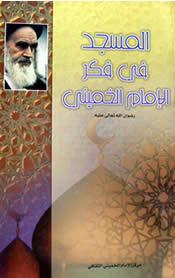
64. Other opinions by Muslim clerics and Intellectuals about the political and military uses of the mosque:
65. Arab and Muslim regimes are well aware of the political and military uses made by terrorist and radical Islamic elements, threatening to turn mosques into hotbeds of dissention, terrorism, and spreading the ideas of radical Islam. Therefore, they try to monitor the goings-on in mosques both by controlling the preachers and the contents of their sermons (as is the case with the Palestinian Authority and the Kuwaiti regime[38]). Control is also exercised by having security services monitor the mosques (as practiced by the Palestinian Authority and Egypt).
66. To justify the security activities against mosques, Arab and Muslim regimes have enlisted senior clerics. The most prominent of them is Muhammad al-Tantawi, Sheikh al-Azhar, who is considered the highest religious authority in the Sunni Muslim world. On July 5, 2007, the Muslim Brotherhood website in Egypt stated that the Sheikh had ruled that the country had every right to cause damage to mosques, to seal them and even to destroy them, in the interest of maintaining state security.[39]
67. Al-Tantawi's ruling precipitated an argument after Egyptian clerics expressed their objection to it:
FOOTNOTES
[1] For further information see our June 29, 2008 bulletin
entitled "Contemporary Arab-Muslim anti-Semitism, its Significance and
Implications (Updated to March 2008)" at
http://www.terrorism-info.org.il/malam_multimedia/English/eng_n/pdf/
a_s_170408e.pdf.
[2] For a video of the launching see File No. 3 at
http://www.terrorism-info.org.il/malam_multimedia/English/eng_n/pdf/
hamas_e059.pdf.
[3] For further information see our June 29, 2008 bulletin
entitled "Contemporary Arab-Muslim anti-Semitism, its Significance and
Implications (Updated to March 2008)" at
http://www.terrorism-info.org.il/malam_multimedia/English/eng_n/pdf/
a_s_170408e.pdf.
[4] For the document and its Hebrew translation, see
http://www.terrorism-info.org.il/malam_multimedia//HEBREW/
AUTHORITY-HAMAS/PDF/SEP10_04.PDF.
[5] Bassam Nihad Ibrahim Jarrar was detained (administrative detentions) a number of times by the Israeli security forces and released in March 2006. Feisal Muhammad Salah Hamdan was detained in August 2006, tried, sentenced, imprisoned and expected to be released in the coming months.
[6] http://www.youtube.com/watch?v=VwBfwVuEXis&feature=related.
[7] The Al-Kashef Internet site, apparently affiliated with Hamas, reported that the Hebron district of the PA's endowments ministry instructed that the mosques open only ten minutes before prayers begin and that they close ten minutes afterwards. The instructions were given after the decision was made to replace the imams affiliated with Hamas and to get rid of traces of Hamas in the mosques (Al-Kashef, February 25, 2009).
[8] 8 For further information see our date bulletin entitled
"Hezbollah's use of Lebanese civilians as human shields: the
extensive military infrastructure positioned and hidden in
populated areas" at
http://www.terrorism-info.org.il/malam_multimedia/English/eng_n/
pdf/human_shields.pdf.
[9] Husseinia, named after Hussein bin Ali, is a religious Shi'ite community center which holds cultural and educational activities and provides welfare services. There are many Husseinias in the villages of south Lebanon and though the Shi'ite world in general.
[10] http://www.pacificviews.org/weblog/archives/000702.html
[11] http://www.talkingproud.us/Military042805B.html
[12] http://news.bbc.co.uk/hi/arabic/talking_point/newsid_3620000/3620647.stm
[13] http://www.paldf.net/forum/showthread.php?t=31930
[14] http://newsblaze.com/story/20051230130333nnnn.nb/ topstory.html
[15]
http://www.mnf-iraq.com/index.php?option=com_content&task=
view&id=11618&Itemid=128
[16]
http://www.al-yemen.org/vb/archive/index.php/t-71167.html,
http://www.asharqalawsat.com/details.asp?section=
4&issueno=8990&article=181008&feature
[17] http://www.asharqalawsat.com/details.asp?section=4&article=
243752&issueno=9354
[18] For details, see: "Contemporary Arab-Muslim anti-Semitism, its Significance and Implications" (April 2008), pp. 100-103 [in Hebrew].
[19] http://www.palestine-info.info/arabic/kotbah/2002/24_4_02.htm
[20] See: http://www.policyexchange.org.uk/images/libimages/307.pdf
[21] http://www.timesonline.co.uk/tol/news/uk/article728162.ece,
http://www.guardian.co.uk/world/2003/jan/20/terrorism.uk
[22] http://www.arabia.pl/english/content/view/377/16
[24] http://chiesa.espresso.repubblica.it/articolo/6953?engy
[25] http://www.highbeam.com/doc/1P2-13336852.html
[26] http://www.jihadwatch.org/archives/019686.php
[27] http://religion.info/english/articles/article_385.shtml
[28] http://www.globaljihad.net/view_page.asp?id=52,
http://www.jewishworldreview.com/0303/west031003.asp, see
also New York Times article dated March 9, 2003.
[29] http://www.pww.org/article/articleview/9513
[30] The complete report is available at
http://hsgac.senate.gov/public/_files/IslamistReport.pdf. For an
analysis, see: "Terrorism and Internet: a US Senate report analyzes
the extensive use made by Al-Qaeda of the Internet in its war for
hearts and minds. The report voices concerns over the exposure of
American citizens to the websites of Al-Qaeda and other radical
Islamic organizations" (July 14, 2008).
[31] See: Prof. Hava Lazarus-Yafeh, Chapters in the History of the Arabs and Islam (Jerusalem: Modan, 1969), pp. 69-70 [in Hebrew].
[32] See book by Uriah Furman, Islamiyyun (Tel-Aviv: Maarakhot, 2002), pp. 97-99 [in Hebrew].
[33] Source: http://www.islamonline.net/servlet/Satellite?pagename=
IslamOnline-Arabic-Ask_Scholar/FatwaA/FatwaA&cid=1122528608354.
See also: forum of Muslim scholars in Iraq associated with the
anti-American camp:
http://iraq-amsi.org/news.php?action=view&id=5324&d92cf9d3f29d6bf6a83651ac4f9cfad8
[34] Source:
http://www.alsalafway.com/cms/news.php?action=news&id=1984. See also:
http://www.Qardawi.net/site/topics/article.asp?cu_no=2&item_no=
3598&version=1&template_id=230&parent_id=17
[35] Ibid.
[36] http://iraq-amsi.org/news.php?action=view&id=
5324&d92cf9d3f29d6bf6a83651ac4f9cfad8
[37]
http://209.85.129.132/search?q=cache:vgmL7Lv7w6EJ:www.ahlalhdeeth.com/
vb/attachment.php%3Fattachmentid%3D47093%26d%3D1177493922+
%D8%AF%D9%88%D8%B1+%D8%A7%D9%84%D9%85%D8%B3%D8%AC
%D8%AF+%D9%81%D9%8A+%D8%A7%D9%84%D8%AC%D9%87%
D8%A7%D8%AF&hl=iw&ct=clnk&cd=1&gl=il
[38] On January 23, 2008, the Kuwaiti Ministry of Religious
Endowments and Islamic Affairs cited the Kuwaiti Minister: "The
mosque is not just a place of worship but also a scene of unity and
social solidarity [among Muslims]. The mosque is also a place to
spread culture and to spread the spirit of moderation among the
public." The Minister of Awqaf and Islamic Affairs also noted that
the mosque was meant to spread Islam and to establish a spirit of
good citizenship and patriotism
(http://www.islam.gov.kw/site/news/details.php?data_id=6207).
[39] http://www.islamonline.net/servlet/Satellite?c=ArticleA_C&cid=
1183483978515&pagename=Zone-Arabic-Shariah%2FSRALayout
[40] ibid
Dr. Reuven Erlich is Director, The Intelligence and Terrorism Information
Center at the Israel Intelligence Heritage & Commemoration Center
(IICC).
This article is from the Intelligence and Terrorism Information
Center at the Israel Intelligence Heritage & Commemoration Center and
was published March 1, 2009. The Overview is archived at
http://www.terrorism-info.org.il/malam_multimedia/English/eng_n/html/
hamas_e065.htm. You can access the complete article in PDF format
from the Overview. The images in the version presented here does not
contain the complete set of images in the original article; and the
Hebrew in Footnote #4 was omitted.
| HOME | March-April 2009 Featured Stories | Background Information | News On The Web |